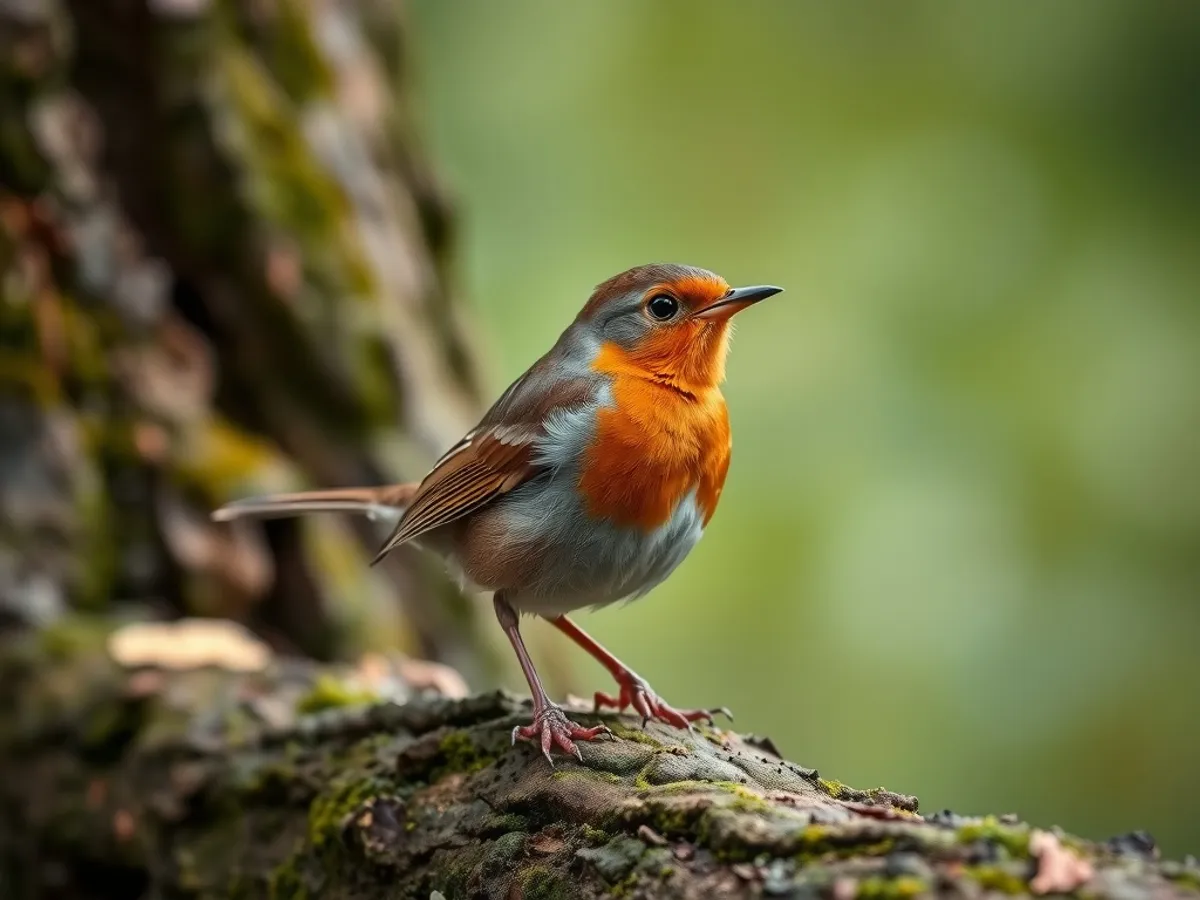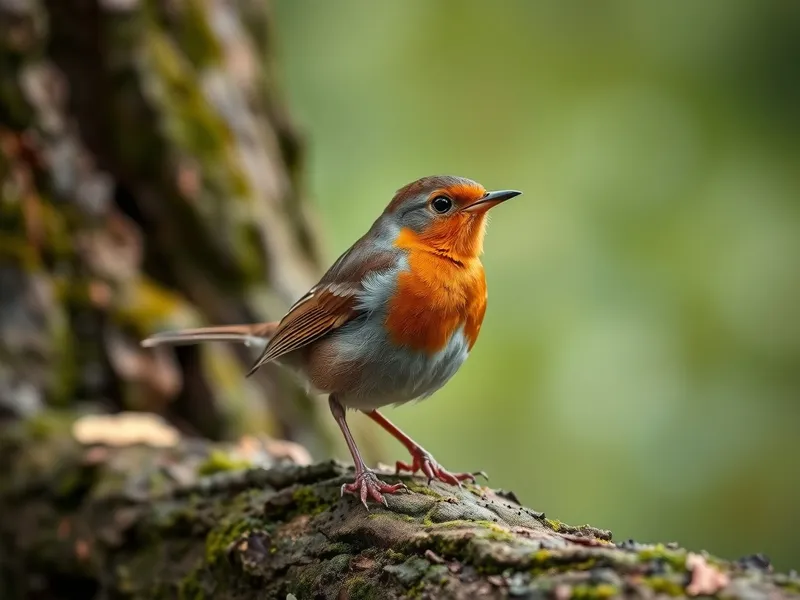
European Robin
Erithacus rubecula

Meet the European Robin
The European Robin is a small, plump songbird recognized by its striking orange-red breast and face, contrasting with olive-brown upperparts and whitish underparts. Commonly found across Europe, this bird is known for its melodic song, which can be heard throughout the year but is especially prominent during winter. Robins are territorial and often display boldness around humans, frequently seen in gardens and woodlands searching for invertebrates. Their friendly appearance has made them cultural icons, especially in British folklore and holiday traditions.
Classification
Bird
Habitat
Woodlands, gardens, parks, and hedgerows
Diet
Omnivore
Lifespan
1-3 years in the wild
Conservation
Least Concern
Weight
14-21 g
📖Fascinating Facts
Year-round Singer
The European Robin is one of the few British birds that sings all year round, including during the winter months.
Distinctive Eggs
Robin eggs are small and white or pale blue with reddish speckles, typically laid in well-hidden nests close to the ground.
Habitat Adaptation
Robins thrive in a variety of habitats, from deep forests to urban gardens, adapting well to human-altered environments.
📋Detailed Description
The European Robin (Erithacus rubecula) is a small passerine bird, typically measuring 12.5–14.0 cm in length with a wingspan of 20–22 cm and weighing between 14–21 grams. Its most distinctive feature is the vivid orange-red face and breast, bordered by a greyish-white belly and olive-brown upperparts. The bill is slender and adapted for gleaning insects, while the legs are relatively long for its size, aiding in ground foraging. Robins possess large, dark eyes, which enhance their vision in low light, an adaptation for their crepuscular activity. Both sexes are similar in appearance, though juveniles lack the red breast, instead displaying mottled brown plumage for camouflage. The robin's song is a complex, melodious sequence of notes, used for territory defense and mate attraction, and is notable for being sung year-round, including during winter. This species is highly territorial, with both males and females defending feeding and nesting areas aggressively. Robins are generally solitary outside the breeding season, but may tolerate mates within their territory. Their adaptability to human-altered landscapes, such as gardens and parks, has contributed to their widespread presence across Europe.
💡 Did you know?
Despite their popularity and friendly appearance, European Robins can be surprisingly aggressive, sometimes fighting intruders to the death to defend their territory.
🔬Research & Sources
Wikipedia Summary
The European robin, known simply as the robin or robin redbreast in the British Isles, is a small insectivorous passerine bird that belongs to the Old World flycatcher family Muscicapidae. It is found across Europe, east to Western Siberia and south to North Africa; it is sedentary in the west and south of its range, and migratory in the north and east of its range where winters are harsher.
Last Modified: 5/26/2025
🎭Behavior & Social Structure
European Robins are primarily diurnal but are also active during dawn and dusk, especially in winter when daylight is limited. They forage mainly on the ground, hopping or running short distances to locate prey, which includes insects, spiders, earthworms, and, in colder months, seeds and berries. Robins are known for their boldness around humans, often following gardeners to snatch exposed invertebrates. Territoriality is a hallmark of their behavior; both sexes maintain and defend territories with song and visual displays, and physical confrontations can occur, sometimes resulting in injury or death. Singing is most intense during autumn and winter, as robins re-establish territories after the breeding season. They exhibit a 'cocked tail' posture and may flick their wings or tail as a threat display. Social interactions are generally limited to the breeding pair, with little flocking behavior observed outside migration periods.
👶Reproduction & Life Cycle
The breeding season of the European Robin typically extends from March to July, with some pairs raising two or even three broods per year. Courtship involves the male singing and offering food to the female. Nests are built by the female, usually in dense vegetation, tree roots, banks, or even in artificial sites such as sheds or flowerpots. The nest is a cup-shaped structure made of moss, leaves, and grass, lined with finer materials. Clutch size ranges from 4 to 6 eggs, which are white or cream with reddish speckles. Incubation lasts 13–14 days and is performed solely by the female, while the male provides food. Both parents feed the altricial chicks, which fledge after 12–15 days. Juvenile robins are independent within a few weeks but remain in the natal territory until dispersal.
🛡️Adaptations & Survival
European Robins have evolved several adaptations for survival in temperate climates. Their cryptic juvenile plumage reduces predation risk, while the adult's bright breast serves as a visual signal in territorial disputes. Their song repertoire is unusually rich for a small bird, facilitating communication in dense habitats. Robins possess a high metabolic rate and can enter a state of torpor during cold nights to conserve energy. Their ability to exploit a wide range of food sources, including anthropogenic ones, allows them to thrive in urban environments. Migratory populations exhibit physiological changes, such as increased fat reserves and altered muscle composition, to support long-distance flights. The robin's visual system is adapted for low-light conditions, aiding foraging at dawn and dusk.
📚Research Sources
🎨Cultural Significance
The European Robin holds a prominent place in European folklore, especially in the British Isles, where it is associated with Christmas and often depicted on holiday cards. Legends link the robin's red breast to religious symbolism, and it is considered a symbol of renewal and hope. In literature and poetry, the robin is frequently portrayed as a friendly and approachable bird, sometimes as a messenger or guide. Its presence in gardens has made it a favorite among birdwatchers, and it was voted the national bird of the United Kingdom in 2015. The robin also appears in nursery rhymes, stamps, and as a motif in decorative arts.
🔬Recent Research & Discoveries
Recent studies have focused on the robin's migratory orientation, revealing the use of Earth's magnetic field for navigation, mediated by specialized photoreceptor proteins (cryptochromes) in the eye. Genomic analyses have identified genes linked to migratory behavior and song complexity. Research into urban ecology has shown that robins adjust their singing frequency and timing in response to anthropogenic noise and artificial light. Long-term ringing (banding) programs have provided insights into survival rates, dispersal, and population trends. Studies on disease ecology have identified susceptibility to avian malaria and trichomonosis, though these have not caused significant population declines.
🎥Wildlife Videos

The Robin Documentary
"With its cheerful song and vibrant red breast, the robin has captured the hearts of people around the world, earning its title as ...
The Wonders Of Nature

Europe's Great Wilderness | Episode 2: Europe's Green Heart | Free Documentary Nature
Europe's Great Wilderness - Episode 2: Europe's Green Heart | Wildlife Documentary Watch 'Europe's Great Wilderness - Episode ...
Free Documentary - Nature

Things you need to know about ROBINS!
Robins have long been considered as the UKs favourite bird so it is only fitting that they are also the unofficial national bird of the ...
A Shot Of Wildlife

Wild Europe - Kingdom of the Beasts | Free Documentary Nature
Wild Europe - Home of the Beasts | Free Documentary Nature Watch 'Europe's Great Wilderness - Episode 1' here: ...
Free Documentary - Nature

Most People Dont Know These 8 Facts About ROBINS
Robins are a familiar garden bird, so it may surprise you that not everything about them is common knowledge. In this video I ...
A Shot Of Wildlife

The European Robin: A Surprising Story of Intelligence and Imagination
The Surprising Intelligence of the European Robin #wildlife Welcome to my youtube channel Hello dosto ...
JINENDRA SINGH PHOTOGRAPHY 🕵️♂️
🌍Habitat Information
The European Robin typically inhabits Woodlands, gardens, parks, and hedgerows environments. European Robins have adapted to their environments with specialized features and behaviors.
Primary Habitat:
Woodlands, gardens, parks, and hedgerows
More detailed habitat information will be available soon.
🛡️Conservation Status
The European Robin is currently classified as Least Concern. Conservation efforts are crucial for preserving this species for future generations.
Common Threats:
- 🏠Habitat loss and fragmentation
- 🌡️Climate change impacts
- 🎯Hunting and poaching
- 🏭Human-wildlife conflict
⚠️Threats & Conservation Challenges
Currently classified as Least Concern by the IUCN, the European Robin faces localized threats including habitat loss, predation by domestic cats, window collisions, and pesticide use reducing invertebrate prey. Climate change may alter migratory patterns and breeding phenology, potentially impacting population dynamics. In some regions, robins are affected by nest predation from corvids and mammals. However, their adaptability to human environments and generalist diet have buffered them against severe declines. Long-term monitoring suggests stable or increasing populations across much of their range, though continued urbanization and agricultural intensification remain concerns.
🔬Scientific Classification
Scientific Name
Erithacus rubecula
Classification Hierarchy
🔍 About Taxonomic Classification
Taxonomic classification is a hierarchical system used by scientists to classify and organize living organisms based on shared characteristics and evolutionary relationships.
The system moves from broad categories (Kingdom) to increasingly specific ones, with each animal's scientific name typically consisting of its Genus and species.
📝Community Notes
Share your observations and insights about the European Robin with our community of wildlife enthusiasts.
Join Our Community
Sign in to share your observations and connect with fellow wildlife enthusiasts.
Sign In to ContributeNo community notes yet
Be the first to share your observations about the European Robin!
Explore European Robin
Select a tab above to learn more about this amazing animal.
📸Photo Gallery
No photos available for this animal yet.
🌟Discover More Wildlife
Continue your journey of discovery with more fascinating animals from our database
